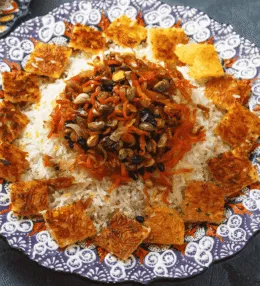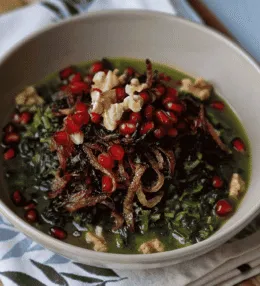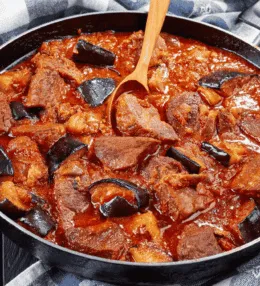
- View
Table of Contents
ToggleDal Bhat is far more than just food in Nepal. It is a daily ritual, a symbol of nourishment and cultural identity. Found in homes, roadside eateries and mountain lodges alike, this humble lentil and rice combination feeds people from every walk of life, from farmers in the lowlands to trekkers in the Himalayas.
What makes Dal Bhat special is its balance of simplicity and depth. It’s not just a meal but a complete experience, served with a selection of accompaniments that reflect the local landscape and seasonal ingredients. Eating Dal Bhat is less about variety and more about comfort, routine and satisfaction.
Want to dive deeper into Nepalese Cuisine? Don’t miss our post on 15 Traditional Nepalese Foods to Try
What Is Dal Bhat?
Dal Bhat is a plate of steamed rice served with lentil soup. But the term often refers to a full set meal that includes vegetable curries, pickles, greens and sometimes meat or yoghurt. It is filling, wholesome and tailored to suit both vegetarian and non-vegetarian diets.
Dal Bhat is eaten throughout the country, with regional touches adding variety. In the hills, you might find it with gundruk, a fermented leafy green. In the plains, it could be served with spicy mustard greens or chicken curry. Every household has its own version, yet the heart of the dish remains unchanged.
Ingredients and Taste
The dal, or lentil soup, is made using yellow lentils like moong or masoor, boiled and seasoned with garlic, turmeric, cumin and sometimes tomatoes or ginger. It has a comforting, earthy flavour with subtle spices that warm rather than overwhelm the palate.
The rice is plain but often generous in portion, acting as a neutral base to absorb the dal and other sides. The curries served with it might include potatoes, cauliflower, okra or pumpkin, each cooked with mild spices and a hint of mustard oil or fenugreek.
Aachar, or pickle, adds brightness and heat. It could be made from radish, tomato, or even mango, depending on the region. The combination of these elements creates a meal that is balanced in taste, nutrition and texture, satisfying both body and soul.
A Taste of History
Dal Bhat has deep roots in Nepalese life, believed to have evolved from ancient grain and pulse based meals common to South Asia. Its widespread adoption came from its affordability, simplicity and adaptability to Nepal’s terrain and agriculture.
It is not just a rural tradition. In cities and towns, Dal Bhat continues to be the backbone of everyday eating. Even in high altitude trekking zones, it is the most reliable and sustaining meal available, often the first taste of local food that visitors experience.
For many Nepalese people, Dal Bhat is a lifelong staple, eaten twice a day without ever becoming boring. Its endurance speaks volumes about its importance. It adapts with the seasons, absorbs local character and reflects the spirit of a community that values resilience and nourishment.
From the foothills of the Terai to the heights of the Annapurna, Dal Bhat remains a symbol of hospitality, sustenance and quiet pride. Trying it is not just about eating a meal; it is stepping into the rhythm of Nepalese life, one plate at a time.

Nepalese Dal Bhat (Lentil and Rice Platter)
Ingredients
For the Dal (Lentil Soup):
- 1 cup split yellow lentils moong dal or masoor dal
- 1.5 litres water
- 1 medium tomato chopped
- 1 teaspoon turmeric powder
- 1 teaspoon salt or to taste
- 2 tablespoons ghee or mustard oil
- 1 teaspoon cumin seeds
- 1 dried red chilli
- 3 garlic cloves minced
- 1 pinch asafoetida hing
- Fresh coriander chopped (for garnish)
For the Bhat (Rice):
- 2 cups basmati rice
- 4 cups water
- 1 teaspoon salt
Optional Accompaniments (recommended):
- Sautéed spinach or mustard greens
- Aloo bhujuri spiced fried potatoes
- Tomato achar pickle
- Sliced cucumber or radish
Instructions
- To begin, rinse the lentils thoroughly under cold water until the water runs clear. In a large pot, combine the lentils with 1.5 litres of water, chopped tomato, turmeric, and salt. Bring to a boil over medium heat, then simmer for 25 minutes until soft and creamy. Skim off any foam during cooking.
- While the dal simmers, wash the rice under running water using a gentle swirling motion to remove excess starch. Drain well and set aside. This ensures fluffy, separate grains once cooked.
- In a separate saucepan, bring 4 cups of water to a boil. Add the rice and salt. Once boiling, reduce the heat to low, cover with a tight fitting lid, and cook for 15 minutes. Do not lift the lid during this time to avoid steam loss.
- Check the dal for doneness by pressing a lentil between your fingers; it should mash easily. Adjust salt if needed. Keep warm on low heat while preparing the tempering (tadka).
- To prepare the tadka, heat ghee or mustard oil in a small pan. Once hot, add cumin seeds, dried red chilli, minced garlic, and a pinch of asafoetida. Sauté on low heat until garlic is golden and aromatic, about 1 to 2 minutes.
- Carefully pour the hot tadka over the simmering dal. It will sizzle on contact. Stir well to blend the flavours. Garnish with fresh coriander and cover for a few minutes to let the aroma infuse fully.
- For a vegetable side, quickly sauté spinach or mustard greens in a small pan with oil, garlic, and a pinch of salt. Cook until wilted and tender, about 5 minutes. This adds nutritional balance to the plate.
- Prepare a quick tomato achar by mixing chopped tomatoes with sesame seeds, green chilli, mustard oil, and lemon juice. Leave to marinate briefly while everything else finishes.
- Fluff the rice gently with a fork once done. Avoid stirring too vigorously to maintain the integrity of the grains. Keep covered until ready to serve.
- To serve, plate a generous mound of rice in the centre of each dish. Ladle warm dal over or beside the rice. Arrange sautéed greens, aloo bhujuri, tomato achar, and fresh cucumber or radish on the side. Encourage diners to mix elements to their taste. Serve hot with love and gratitude.
Nutrition
You May Also Like







Leave a Review